Contents
Fruit and berry crops for normal growth and development require fertile soil containing a sufficient amount of minerals. Raspberry ash is an organic fertilizer that will help make up for the deficiency of useful elements.

Ash top dressing will help strengthen young shoots
The benefits of ash for raspberries
The ash formed after the combustion of wood contains all the elements that were contained in the original material. The presence of potassium, sulfur, calcium, iron, phosphorus, magnesium and a number of other minerals in an easily accessible form for raspberries makes this organic product a good fertilizer.
Using ashes for raspberries as fertilizer
- helps to fill the deficiency of minerals in the soil;
- improves the structure of the soil, making it looser;
- reduces the level of soil acidity by adding alkali to it;
- activates the process of photosynthesis;
- helps to regulate the process of budding and fruiting;
- promotes the growth of the root system;
- strengthens the immunity of raspberries and reduces the likelihood of developing fungal diseases;
- repels harmful insects from raspberry bushes;
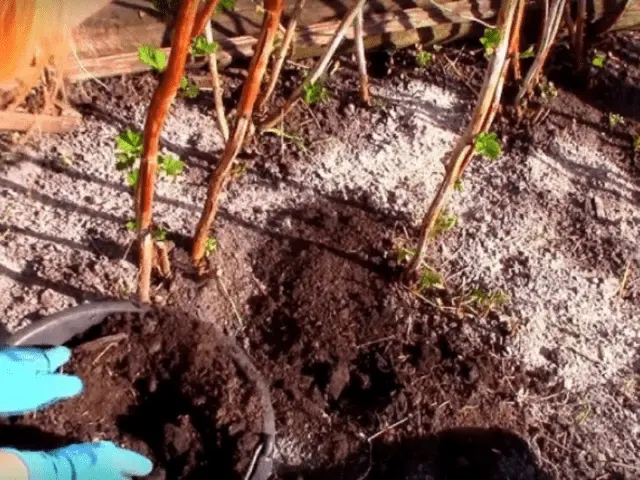
For the first time, raspberries are fed with ashes in early summer.
Advantages and disadvantages
The ash that remains after burning wood materials is one of the popular organic fertilizers. To use it correctly, you need to know the advantages and disadvantages of ash.
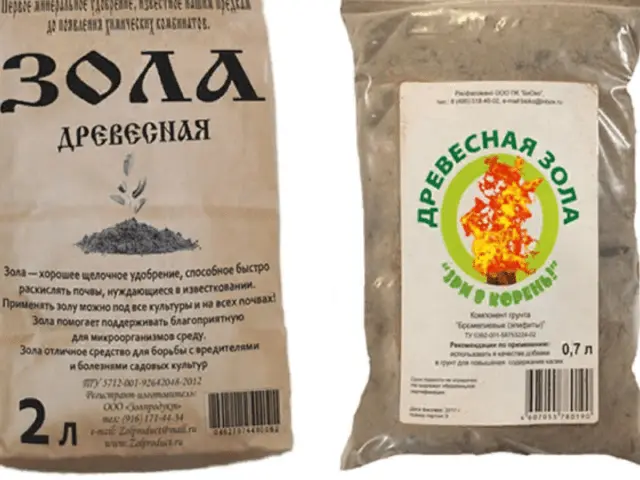
One of the advantages of this fertilizer is its low cost.
Pros:
- the content of a large amount of minerals;
- naturalness and availability of the product;
- ease of use.
Cons:
- the impossibility of determining the exact dosage of the agent due to the fact that the composition of the burnt wood may be different;
- the absence of nitrogen in the composition, which necessitates the use of additional fertilizers for top dressing and excludes the possibility of using ash in the spring;
- poor efficiency on saline soils;
- the need to be careful when using – direct contact of the fertilizer with the root system can cause a burn of the latter;
- the inexpediency of applying after nitrogen fertilizing, the alkali contained in this fertilizer, when interacting with nitrogen, turns into ammonia, as a result of which it will not be able to reduce the acidity of the soil, and the lion’s share of nitrogen will simply disappear.
Signs of a micronutrient deficiency
The lack of one or another trace element can be determined by the appearance of the vegetative parts of raspberries:
- If a plant lacks iron, its leaves turn yellow, but the veins remain green. This is also indicated by the drying of the tops of the shoots.
- Potassium deficiency is indicated by twisting of the leaves and the appearance of a brown border on them.
- With an insufficient amount of phosphorus, raspberry leaves become burgundy-purple, and the shoots acquire a blue tint.
- When a plant lacks sulfur, the veins on the leaves turn yellow and then turn white.
- If a small, gradually increasing yellow spot appears in the middle of the leaf plate, the plant needs magnesium.
All these trace elements are present in the ash formed after the burning of hardwood trees.
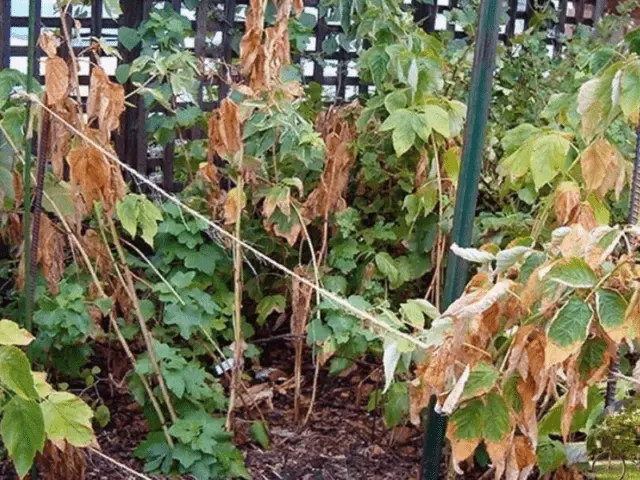
If the raspberry is not fed, it may die.
When to feed raspberries with ashes
For the first time, raspberries are fed with ash during planting. Then this organic matter is included in the nutrient composition, laid in the planting hole. Such top dressing helps the plant to adapt to a new place and start growing.
Useful substances obtained during planting, raspberries will last for two years, so the next time fertilizers are applied to the soil in the third year of the plant’s life.
Wood ash for raspberries in spring
The yield of raspberries largely depends on the state of its vegetative parts. Therefore, in the spring, when the buds are just beginning to bloom and new shoots are growing at the base of the old stems, the plant must be fed.
Fertilizing during this period will help strengthen the plant’s immunity, as well as create good conditions for budding and fruiting.
In the spring, it is possible to make ashes under raspberries, only such top dressing will not bring benefits. At this time, the plant needs nitrogen, which is not contained in wood ash. For spring top dressing, it is better to use other organic fertilizers – cow dung or bird droppings.
Wood ash for raspberries in summer
The summer period for raspberries is the most crucial, because it is at this time that the culture goes through such important stages of development as budding, ovary formation and fruiting.
Ash for raspberries during flowering is the activation and normal course of all vegetative processes, which will result in a good harvest of healthy sweet berries.
Wood ash for raspberries in autumn
Applying ash as fertilizer to raspberries in the fall will help the plants prepare for winter. The introduction of this organic fertilizer will help strengthen the root system and activate the process of lignification of young shoots.
At this time, you can use the ashes in their pure form or a liquid extract from it.
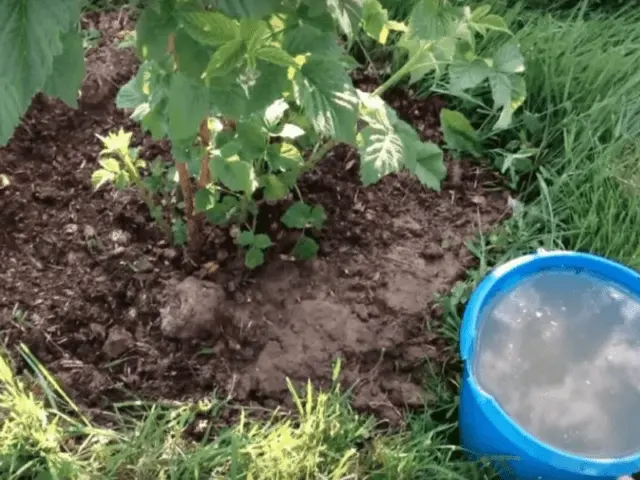
Fertilizers need to be applied to pre-moistened soil
How much ash do raspberries need
In order for top dressing to bring the desired effect, you need to observe the correct dosage of fertilizer. When digging or laying under mulch per 1 sq. m will need a glass of dry matter, and when using a liquid extract – 0,5 liters of the finished product for each bush.
How to use ashes for raspberries
Raspberry ash can be used both in dry and liquid form. This fertilizer is applied to the soil in the root zone or the so-called leaf feeding is performed, that is, raspberry bushes are sprayed with a liquid composition.
dry ash
In dry form, ash can be used as an independent fertilizer or as a separate component in organic mixtures.
In the first case, the dry matter is scattered under the bushes and the soil is shallowly dug up or placed under a layer of mulch. And in the second, they simply add a certain amount of fertilizer to rotted cow manure, compost or humus.
Given the peculiarity of ash to change its chemical formula under the influence of sunlight, this fertilizer must be incorporated into the soil. Otherwise, raspberries simply will not be able to assimilate useful substances that have been converted into insoluble compounds. Accordingly, there will be no benefit from such top dressing.
Liquid ash extract
It is generally accepted that fertilizing with a liquid extract is more effective, which is poured under the root or sprayed on the bushes, that is, fertilizer is applied on the sheet.
In the process of preparing such a remedy, 1 tbsp. dry matter pour a bucket (10 l) of water at room temperature, stir well and leave to infuse for 3-4 days.
For root irrigation, the solution is diluted in a ratio of 1×2, and for top dressing on a leaf – 1×4.
Unused product can be poured into glassware and stored closed for two months.
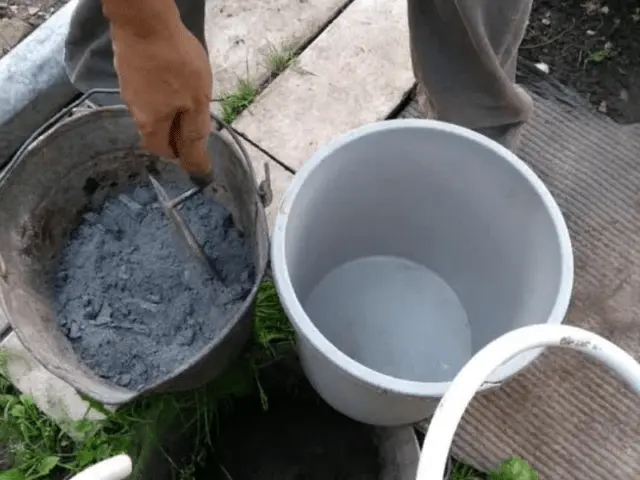
It is very easy to prepare ash fertilizer
Conclusion
Ash for raspberries is an affordable organic fertilizer, which contains almost all the elements necessary for this plant. Timely top dressing will help prevent diseases of the bushes and get a good harvest of sweet berries.









